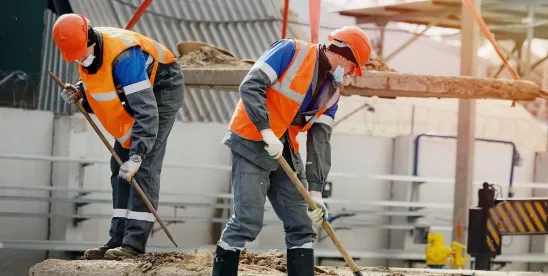The Equal Employment Opportunity Commission (EEOC) issued guidance on preventing harassment in the construction industry on June 18, 2024. The EEOC states in Promising Practices for Preventing Harassment in the Construction Industry that specific guidance was necessary because workplace harassment remains prevalent in the construction industry and some of the most egregious incidents of harassment it has investigated have occurred in the industry.
The EEOC also points out that aspects of the construction industry contribute to higher risk of harassment, such as primarily male workforces, workplaces where there is pressure to conform to traditional stereotypes, and decentralized workplaces without onsite executive oversight. These factors can be exacerbated by the presence of multiple employers on a worksite and the cyclical, project-based nature of construction, it notes.
The guidance follows designation of the construction industry as a focus of the EEOC Strategic Enforcement Plan for Fiscal Years 2024-2028.
Although the guidance does not have the force and effect of law and does not create any new legal obligations, the EEOC will likely consider whether an employer has implemented the recommended practices when evaluating compliance with nondiscrimination statutes.
The EEOC states that the guidance focuses on five “core principles” that have been effective in preventing and addressing harassment:
- Committed and engaged leadership.
- Consistent and demonstrated accountability.
- Strong and comprehensive harassment policies.
- Trusted and accessible complaint procedures.
- Regular, interactive training tailored to the audience and the organization.
Committed and Engaged Leadership
The guidance calls leadership’s consistent and demonstrated commitment to combatting harassment the “cornerstone” of a successful anti-harassment strategy. The EEOC encourages project owners and general contractors to prioritize worksite-wide collaboration, exercise anti-harassment oversight over all contractors at worksites, and provide resources to subcontractors to help prevent harassment. As an example, the guidance suggests that general contractors refer smaller contractors that may need assistance with their compliance program to resources on the EEOC website.
Consistent and Demonstrated Accountability
The guidance suggests that project owners and general contractors consider requiring that contract bids include a written plan to prevent and address workplace harassment. The plan should include a harassment policy, an accessible complaint system, regular anti-harassment training, and a discipline policy that is prompt, consistent, and proportionate to the severity of the harassment. According to EEOC, general contractors should consider providing or coordinating sitewide preventive measures, such as training, and could monitor subcontractor harassment prevention and complaint responses.
Strong and Comprehensive Harassment Policies
According to the guidance, project owners and general contractors should have clear and comprehensive anti-harassment policies and ensure that subcontractors also have such policies. These policies should include:
- Identification of who is covered by the policy;
- A statement that harassment is prohibited;
- A clear description of prohibited conduct;
- An explanation of the complaint reporting process;
- Encouragement for employees to report harassment and other inappropriate conduct;
- Commitment to prompt, impartial, and thorough investigations;
- Encouragement for employees to participate in investigations;
- Assurances that the company will take immediate, reasonable, and proportionate corrective action; and
- Prohibition of retaliation.
Trusted and Accessible Complaint Procedures
The EEOC recommends that anti-harassment policies and complaint procedures be in writing, communicated in a clear, easy to understand style and format in all languages commonly used by workers at the site, and posted in consistent, easy-to-find places.
The EEOC suggests that if multiple employers onsite have their own anti-harassment policies, the project owner or general contractor should review the policies for consistency.
Anti-harassment policies should identify multiple methods to complain and multiple employer representatives to whom employees can bring complaints. Employees should be trained on appropriate complaint procedures, and managers should be trained in how to respond to complaints they receive. Once a complaint is made, managers should be instructed to be vigilant to avoid or mitigate ongoing harassment or retaliation.
The EEOC suggests that the general contractor can play an oversight and coordinating role in worksite complaint systems and should consider creating a shared, site-wide alternative complaint channel, such as an ombudsperson or hotline that accepts anonymous complaints. The guidance also suggests that the general contractor require subcontractors to report all harassment complaints to the general contractor, particularly where there is alleged harassment of one subcontractor’s employee by another subcontractor’s employee. The goal is to permit the general contractor to monitor harassment reports from the entire worksite and to help ensure that appropriate employers are notified of harassment complaints involving their employees.
Regular, Interactive Training Tailored to the Audience and the Organization
The EEOC recommends regular, interactive, and comprehensive anti-harassment training of all workers on a construction site. It also suggests that general contractors review subcontractors’ training policies and plans to ensure consistency and sufficiency.
Practical Tips
While the EEOC guidance does not create new legal requirements, it provides insight into the anti-harassment activities the EEOC believes responsible employers should undertake to comply with nondiscrimination laws. EEOC investigators clearly will evaluate construction employer anti-harassment policies and practices against the guidance’s recommendations.
Construction industry employers should review the guidance’s recommendations and consider implementing any that would strengthen their anti-harassment policies and practices.



 />i
/>i
